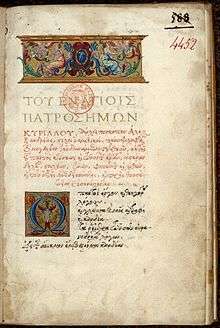Angelo Vergecio
Angelo Vergecio (Greek: Άγγελος Βεργέκιος, French: Ange Vergèce; 1505–1569) was a Greek copyist from Crete active in Venice and France. He became a royal scribe for Francis I of France and his successors, was responsible for copying over fifty Greek manuscripts, and played a role in the dissemination of Greek among the humanist circles in France. His handwriting formed the basis of the grecs du roi typeface designed by Claude Garamond.

Title page of the Hexameron, copied by Vergecio
Bibliography
- Alphonse Dain. « La fille d’Ange Vergèce », Humanisme et Renaissance 1 (1934) p. 133-144.
- Alphonse Dain. « Commerce et copie de manuscrits grecs », Humanisme et Renaissance 4 (1937) p. 395-410.
- Charles Delattre. Nommer le monde : origine des noms de fleuves, de montagnes et de ce qui s'y trouve. Villeneuve-d'Ascq : Presses universitaires du Septentrion, 2011.
- Ernst Gamillscheg, Dieter Harlfinger and Herbert Hunger (dir.) Repertorium der griechischen Kopisten 800-1600, Veröffentlichungen der Kommission für Byzantinistik 3-1, Vienna : Österreichische Akademie der Wissenschaften, 1981.
- Philip Hofer et G. W. Cottrell Jr. « Angelos Vergecios and the bestiary of Manuel Philes », Harvard Library Bulletin 8 (1954) p. 323–339.
- Marie-Pierre Laffitte. Reliures royales du Département des Manuscrits (1515-1559). Paris : BNF, 2001.
- Marie-Pierre Laffitte. « Manuscrits de la famille Vergèce en reliures à médaillons peints (1554-1569) », Revue de la Bibliothèque nationale de France 12 (2002), p. 25-31.
- Émile Legrand. « Ange Vergèce », Bibliographie hellénique. Paris : 1885. t. I, pp. cxxv-cxxxvi.
- Pierre de Nolhac. Ronsard et l'humanisme. Paris : Champion, 1921, p. 39.
- Henri Omont. Catalogues des manuscrits grecs de Fontainebleau sous François Ier et Henri II. Paris : Imprimerie nationale, 1889. 4°, XXXIX-466 p.
- Henri Omont. « Procès d’Ange Vergèce au Châtelet et au Parlement de Paris (1561) », Bibliothèque de l’École des Chartes 77 (1916) pp. 516-520.
- Glenn Peers, « Forging Byzantine animals : Manuel Philes in Renaissance France », Rivista di studi bizantini e neoellenici 49 (2012), pp. 79-103.
- Glenn Peers. « Thinking with Animals: Byzantine natural history in sixteenth-century France », Bibliothèque d’Humanisme et Renaissance 68 (2006), pp. 457–484.
- Glenn Peers. « A Cretan in Paris : Angelos Vergekios and Greek natural history in the French Renaissance », Pepragmena Th’ Diethnous Kretologikou Synedriou. Elounta, 1-6 Oktovriou 2001. Tomos B2: Architetektonike, Istoria tes Technes, Nomismatike, Topographia kai Topiographia, Diepistemonikes Symvoles, Herakleion, 2004 (2006), p. 419-440.
gollark: Yes, but they are basically just universal constructors which build themselves and are gigantic.
gollark: If someone built one you could stop it with a few gliders basically anywhere on the million-cell mess.
gollark: In GOL replicators are quite hard.
gollark: Is in newish snapshots for chunkloading.
gollark: ./chunk.
This article is issued from Wikipedia. The text is licensed under Creative Commons - Attribution - Sharealike. Additional terms may apply for the media files.